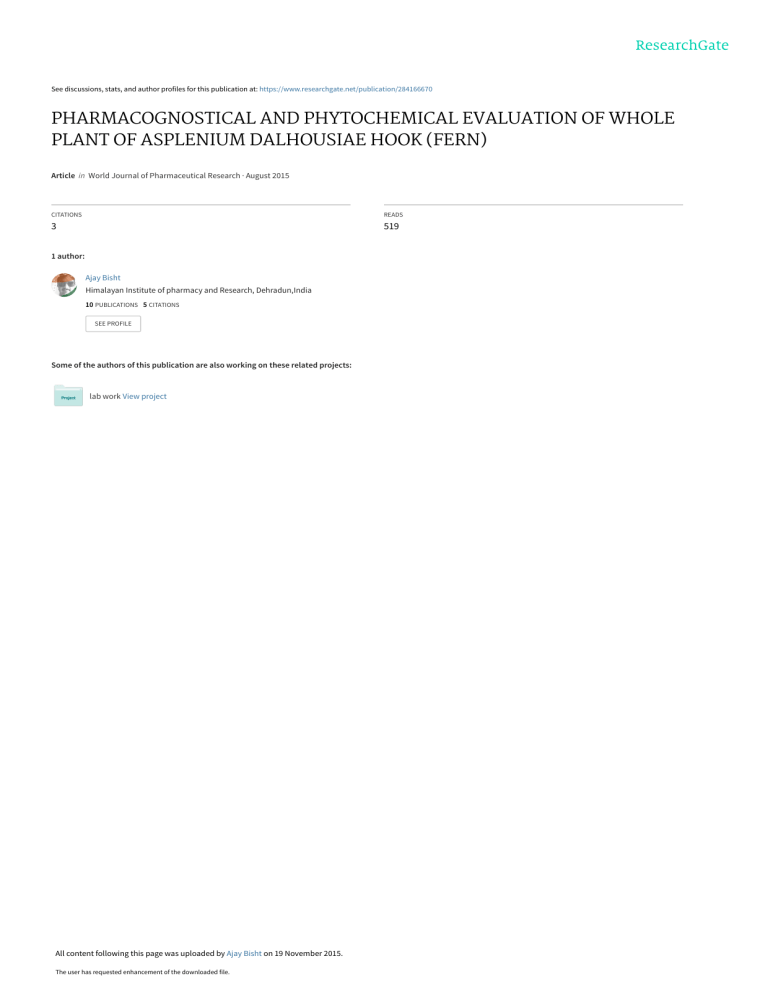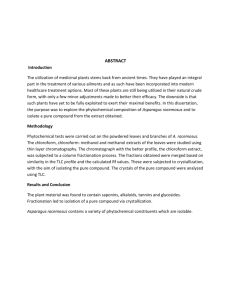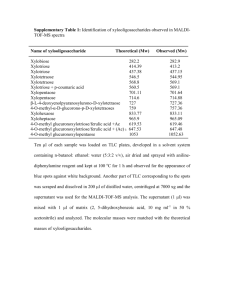
See discussions, stats, and author profiles for this publication at: https://www.researchgate.net/publication/284166670 PHARMACOGNOSTICAL AND PHYTOCHEMICAL EVALUATION OF WHOLE PLANT OF ASPLENIUM DALHOUSIAE HOOK (FERN) Article in World Journal of Pharmaceutical Research · August 2015 CITATIONS READS 3 519 1 author: Ajay Bisht Himalayan Institute of pharmacy and Research, Dehradun,India 10 PUBLICATIONS 5 CITATIONS SEE PROFILE Some of the authors of this publication are also working on these related projects: lab work View project All content following this page was uploaded by Ajay Bisht on 19 November 2015. The user has requested enhancement of the downloaded file. World Journal of Pharmaceutical Research Bisht et al. World Journal of Pharmaceutical SJIF Research Impact Factor 5.990 Volume 4, Issue 9, 2186-2191. Research Article ISSN 2277– 7105 PHARMACOGNOSTICAL AND PHYTOCHEMICAL EVALUATION OF WHOLE PLANT OF ASPLENIUM DALHOUSIAE HOOK (FERN) Ajay Singh Bisht*, Monika and Divya Juyal Himalayan Institute of Pharmacy and Research, Atak Farm, Rajawala, Dehradun, India. ABSTRACT Article Received on 15 July 2015, Revised on 06 Aug 2015, Accepted on 30 Aug 2015 The present communication attempts to evaluate the Pharmacognostical and preliminary phytochemical studies on the whole plant Asplenium dalhousiae Hook (Aspleniaceae). As there is no detailed work reported on this plant, therefore Pharmacognostical *Correspondence for evaluation Author phytochemical standards were determined .The study revealed specific Ajay Singh Bisht including physicochemical parameters, preliminary identities for the plant, which will be useful in identification, as a Himalayan Institute of Pharmacy and Research, control to abet adulterants and for future standardization work. Atak Farm, Rajawala, Physicochemical studies shows, total moisture content(Leaf 12% and Dehradun, India. roots 7%), total ash(Leaf1% and root 4%), total starch content (Leaf 0.13% and root 0.079%), total sugar content(Leaf 0.19% and root 0.02%), total tannins(Leaf 1.18% and root 0.38%),total phenolics(Leaf 9.27% and root 3.20),total flavonoids(Leaf 1.3% and root 0.09%), total proanthocynadines content (Leaf 0.01% and root0.002%).. Preliminary phytochemical analysis reaveled that various other phyto-components are also present.TLC analysis and method development shows the presence of various other components. KEYWORDS: Asplenium dalhousiae Hook, Pharmacognostical, TLC. INTRODUCTION Asplenium dalhousiae Hook (Aspleniaceae) is a fern (pteriodphyte)found with a rosette of fronds from a rhizome, leaves are rachies green, scaly beneath, blade pinnatifid, 5-15 cm long, with 6 to 13 pairs of lobes. The lobes are 5-12 mm wide. They are found in shady, rocky and ravines in moist soil.[1] Asplenium dalhousiae Hook generally distiunguished by its allied species through its once pinnatified leaves from asplenium exiguum which has bipinnatified leaves. www.wjpr.net It is a genus (Asplenium ) of about 700 species of ferns found Vol 4, Issue 09, 2015. 2186 Bisht et al. World Journal of Pharmaceutical Research extensively worldwide, mostly native to northen Mexico and disjunction to the Himalaya mountains in Asia.[2] In India they generally habitat at IHR (Indian Himalayan Region) includes Kashmir, Himachal, Uttarakhand and many more. The plant found to possess many medicinal activities. Roots of the plant are used in snake bite[3] where as decoction of the roots used as Ghutti in infants.[4] METHODOLOGY The plant was collected from catchment of Bhimtal region in Uttarakhand located in North India, proclaimed as to have ethanopharmacological importance. It was preserved in 70% ethyl alcohol for various other studies. Pharmacognostical and physicochemical evaluation were carried out from shade dried plant powder. Physicochemical standardization methods of the plant were done including determination of moisture content (loss on drying), determination of total ash and acid insoluble ash, extractive values were carried out as per WHO recommendations and authentic procedures mention in Ayurvedic pharmacopoeia of India. Estimation of total Sugar and total starch in plant material was carried out with according to Mont Gomery, 1957 [Spectrophotometric method][15] taking dextrose and starch (soluble), respectively as a standard solution. Whereas total tannins were determined by using Tannic acid as standard and Gallic acid for the determination of total phenolics. In the determination of total flavonoids and total flavonols. Rutin was taken as a standard. Proanthocynidines were estimated by using Catechin as a standard. Fluorescence analysis of both leaves and roots were carried out using different dilutions shown below. In chromatographic processes pre-coated TLC plates were used. TLC method development process was also carried out using various successive extracts. Post-derivatization was done with Anisaldehyde Sulphuric acid reagent. Table. 1 PHYTOCHEMICAL ANALYSIS OF LEAVES EXTRACTS S.No. Compounds 1 Carbohydrate Proteins and 2. Amino Acids Steroides and 3. Triterpenoids 4. Alkaloids 5. Resins 6. Tannis 7. Flavanoids 8. Glycosides 9. Phenols www.wjpr.net Tests Molish’s Hexane Chloroform + - Ethyl Acetate + Methanol Water + - Millon’s + - - - + Choloform + + - - - Mayer’s Test Ferric Chloride Alkaline Reagent Legal Test Lead Acetate + - + + - + + - + + + + + + - Vol 4, Issue 09, 2015. 2187 Bisht et al. World Journal of Pharmaceutical Research Table. 2: PHYTOCHEMICAL ANALYSIS OF ROOTS EXTRACT S.No. Compounds 1 2. 3. 4. 5. Tests 7. Carbohydrates Reducing Sugars Mono sacciharides Non reducing Sugar Tannis Proteins and Amino Acids Oils and Fats 8. Steroides 9. 10. 11. 12. Glycocides Flavanoids Resins Phenols 6. Ethyl Methanol Water Acetate + + + + + + - Hexane Chloroform Test Benedict’s Borfoed’s Fehling’s Ferric Chloride + + - + + + Millon’s - - + + - Filter Paper Libermann Burchand Legal’s Alkaline Reagent Test Lead Acetate + + + - +(Green) - + + + + + + + + +(Deep Red) + + - Table. 3: FLOURSCENES ANALYSIS OF LEAVES EXTRACT S.No. 1. 2. 3. 4. 5. 6. 7. 8. Dilution Visible Light Powder in Methanol Powder in Ethanol Powder in 1N NaoH Powder in 1N HCL Dil HCL Methanol in NaoH Ethanol in NaoH Conc. HCL Green Dark Green Brownish Green Green Light Green Yellowish Green Dark Green Green Long Wave Length Black Black Black Black Black Black Black Light Black Short Wave Length Green Blackish Green Dark Green Light Green Light Green Yellowish Blackish Green Light Green Table. 4: FLOURSCENCES ANALYSIS OF ROOTS EXTRACTS S.No. Dilution 1 2 3 4 5 6. 7. 8. Powder in Methanol Powder in Ethanol Powder in1N NaoH Powder in 1N HCL Powderin Conc.HCL Ethanol in NaoH Methanol in NaoH Dil HCL www.wjpr.net Visible Light Blackish Green Blackish Brownish Brownish Blackish Blackish Blackish Brownish Long Wave Length Blackish Blackish Blackish Blackish Blackish Blackish Blackish Blackish Vol 4, Issue 09, 2015. Short Wave Length Brownish Blackish Dark Green Dark Green Blackish Blackish Blackish Blackish 2188 + - Bisht et al. World Journal of Pharmaceutical Research Table. 5: PHYSICOCHEMICAL ANALYSIS S.No. 1. 2. 3. 4. 5. 6. 7. Parameter Loss on drying Total Starch (%) Total Tannins (%) Total Sugar (%) Total Phenolic (%) Total Flavanoid (%) Total Proanthrocynidines (%) Leaves 12% 0.13 % 1.18% 0.19% 9.27% 1.3% 0.01% Roots 7% 0.079% 0.38% 0.02% 3.20% 0.09 % 0.002% Fig.1 Image of Asplinium dalhousiae Hook taken from the site of collection Table-6: TLC Method Development for whole plant S.No Solvent system H Hex : Et (8:2) 4 spots 1. Hex :Et (7:3) 5 spots 2. Hex : Et (6:4) 4 spots 3. Hex : Et (5:5) 4 spots 4. Hex : Et (4:6) 3 spots 5. Chlo: Met ( 8:2) 3 spots 6. NOTE: *H= Hexane C= Chloroform C Et M 4 spots 1 spot --6 spots 1 spot ---4 spots ----5 spots ----4 spots 1 spot 1 spot 2 spots 2 spots 2 spots Et= Ethyl acetate M= Methanol Wt ----------1 spot 1 spots W= Water RESULTS AND DISCUSSIONS The powdered drug showed yellowish green, bitter odor and taste. The % of moisture content of leaves and roots was 12 and 7 respectively , total ash 1% and 4 %, acid insoluble ash 0.65% and 0.42%, hexane soluble extractive 16.8%, alcohol soluble extractive 39% and www.wjpr.net Vol 4, Issue 09, 2015. 2189 Bisht et al. World Journal of Pharmaceutical Research water soluble extractive 5.6%. A known quantity (10 gms) of dried powder was extracted in a Soxhlet with hexane, chloroform, ethyl acetate, methanol and water for 72 hrs successively and tested for phytochemical analysis. The % of successive extractive values were hexane 2.91, chloroform 3.56, ethyl acetate 0.24, methanol 0.26 and water 1.4. The results of phytochemical analysis are provided in Table _1 and Table_2. TLC analysis and method development of whole plant were also carried out and results found mentioned in Table_6. The result of total starch content, total sugar content, total tannins, total phenolics, total flavonoid, total flavonols content, total proanthocynadines content and total volatile content are presented in Table_5. Results of Fluorescence analysis of both leaves and roots extract were carried out using different dilutions shown in Table_3 and Table_4 respectively. CONCLUSION Pharmacognostical and Phytochemical evaluation on Asplenium dalhousiae Hook provides some specific pharmacognostical and chemical parameters that are useful in the future evaluation and standardization of the whole plant drug. The presence of considerable level of polyphenolic compounds including flavonoids, flavonols, proanthocyanidines, etc. suggested that plant part can also be considered to show antioxidant activity. TLC analysis predicts that hexane and chloroform extract contains maximum amount of spots. So in future the study can be consider to exploit the nature of Phytoconstituents and its pharmacological action. REFERENCES 1. Singh G and. Rawat GS. Ethnomedicinal Survey of Kedarnath Wildlife Sanctuary in Western Himalaya, India. IJFALS, 2011; 1(1): 35-46. 2. T Iwashina and S Matsumoto. Flavonoid Properties of six Asplenium Species in Vanuatu and New Caledonia, and Distribution of Flavonoid and Related Compounds in Asplenium. Bull. Natl. Mus. Nat. Sci., 2011; 37(3): 133–145. 3. S Kumar, G Chand and P Sankhyan. Herbal folk remedies for curing various ailments in lug valley of district kullu, himachal pradesh (n.w. himalaya) International Journal of Ayurvedic and Herbal Medicine, 2013; 3(5): 1308 –1314. 4. Kumari S, Batish DR, SinghHP, Negi K and Kohli RK. An ethnobotanical survey of medicinal plants used by Gujjar Community of Trikuta Hills in Jammu and Kashmir. India Journal of Medicinal Plants Research, 2013; 7(28): 2111-21. www.wjpr.net Vol 4, Issue 09, 2015. 2190 Bisht et al. World Journal of Pharmaceutical Research 5. WHO (2003). World Health Organization Traditional Medicine. WHO Fact Sheet No 134. Geneva:Switzerland. Available online at URL: http://whqlibdocwhoint/fact_sheet/2003/FS_134_revisedpdf (Accessed on 20-2-2012). 6. Pant S, Samant SS, Arya SC. Diversity and indigenous household remedies of the inhabitants surrounding Mornaula reserve forest in West Himalayas. Indian J. Tradit. Knowl., 2009; 8: 606-10. 7. Berk S, Tepe B, Arslan S, Sarikurkcu C. Screening of the antioxidant, antimicrobial and DNA damage protection potentials of the aqueous extract of Asplenium ceterach DC. African Journal of Biotechnology, 2011; 10(44): 8902-08. 8. Germplasm Resources Information Network (GRIN). Taxon: Asplenium ceterach L. United States Department of Agriculture, Agric. Res. Serv. Beltsville Area. http://www.ars-grin.gov/cgibin/ npgs/html/taxon., 2010; 411750. 9. AOAC Official methods of analysis of AOAC International, 16th edition. AOAC International, Suite 400, 2200 Wilson Boulevard, Arlington, Virginia, USA, 1995. 10. Khare PK. The Petiolar structure of some Asplenum specie. Canadian Journal of Botany., 2014; (1): 324-89. 11. Khan A , Medicinal Palnts used in folk recipes by the inhabitants of Himalayan region Poonch valley azad Kashmir (Pakistan) , Journal of basic & Applied Sciences. 2012; 8 th edn: 35. www.wjpr.net View publication stats Vol 4, Issue 09, 2015. 2191

